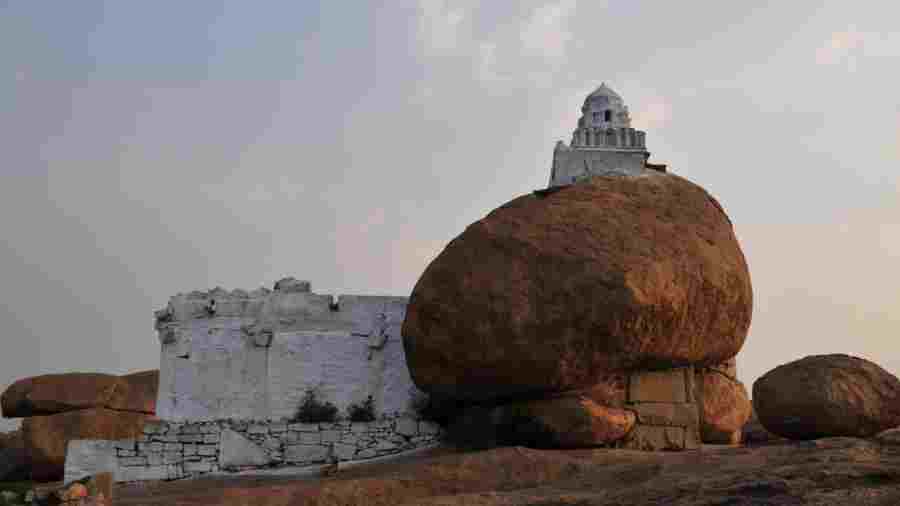Last month, I finally made a long-deferred tour of Hampi. I am not about to describe my travels. Those who have seen those majestic ruins will not need my account, and those who have not will learn nothing from it. I wish to express some very different thoughts evoked by the place.
There is a level of monumentality where ruins cease to be merely ruins: not the sorry remnants of vanished buildings but entities in their own right. They acquire a form, message and personality of their own. This is not merely serendipitous. Great architecture, like all great art, is constructed at many levels. Some might disappear over time, only to reveal the deeper design they had concealed. We can no longer see the intact edifices of Hampi, but we can better discern the conception underlying their structure.
But that is too limited and academic an insight. Ruins incorporate not only what was there at the outset but also what they have acquired from the accretion of centuries. Their very pattern of destruction carries meaning, adding something even in loss. The entire site embodies an unfolding story, layer on layer. The seal of monumentality now set upon it is the latest, but maybe not the last, chapter of the tale.
At Hampi, a harrowing sequence of the story speaks of violence, pillage and slaughter. Improbably soon after the Vijaynagar empire reached its pinnacle, its capital was overrun by the Deccan sultanates. The city was left razed and desolate.
That was in 1565. It’s over two hundred years since Hampi attracted archaeological attention, and barely decades since the tourist traffic swelled. The ravaged stones have found their place in a humbler but no less viable order than when they rose to the skies. Hampi’s moment in history did not end with the battle of Talikota. As historians now tell us, the continuing life of the people through the ages is the ground reality of history, yielding its bedrock narrative.
Historians may feel I am distorting their doctrine in an amateurish way. Let me not trespass further into their territory. For me, the profoundest message of Hampi does not come solely from the monuments but equally from the rocks among which they are set.
These rocks stretch over the landscape in awesome though barren abundance. Many are so weirdly shaped as to assume personalities, as though imbued with some goblin force, or the grander presence of landscape gods. Some are so precariously balanced that one hesitates to pass under them, while others promise to stay put forever. The rocks dominate and overwhelm the scene: even the grandest ruins seem to toss like sailboats in the troughs between the waves of that heaving sea of stone. No doubt the architects of old sought out suitable spaces where their structures could lodge among the rocks, and designed them to conform in shape.
This begs the question of whether the rocks stood centuries ago as we see them today. Rocks are extant in geological time, where the ephemeral traffic of human kingdoms does not register. Even so there must be a decisive instant, perhaps after millennia of weathering, when a rock splits open or topples over. The ‘sister stones’ of Hampi afford a recent instance. These are two boulders said to represent two sisters, turned to stone for denigrating the Hampi monuments. A few years ago, one of them split so dangerously that the place is now closed to tourists.
How often did that happen over the centuries? Ultimately, it doesn’t matter. The stones crafted by human hand continue in the same relationship to those fashioned by nature, absorbed into that immensity. In fact, what with wilful destruction followed by weathering, their space has shrunk further.
Thus the monuments of Hampi, like the pyramids of Egypt or the temples of Angkor, recede into more and more remote frames of reference: from a mighty kingdom that need seek no external validation, to a mass of relics validated in the mundane present, to a sprinkling of tiny puckers on a rockface beyond human time. The equations are not entirely unfavourable to our species. They give a solemn sanction to human existence as adjudged by the grandest measure of earth and universe. We too, it seems, have a place in that design, humbling in scale but reassuring in being there at all.
It is a fitting allegory for the history of a great nation and its venerable people. Like the rest of humankind, we live out our narrow, trivial, violent, unedifying lives from day to day. Humankind everywhere finds a wider and nobler context in which to place itself. In India, the sheer immensity of the land, the numbers and variety of the population, the endlessly rich fabric of its civilization make it easier and also more imperative to derive a fulfilling identity from that teeming expanse.
Yet today, this very narrative is being reversed to untune the harmony worked by time, nature and humanity. As I said, the history of Hampi evinces great violence and destruction, moreover between people of two religions. That is not the whole truth about their relationship: from the composition of their armies to the intermingling evident in their learning, art and architecture, there was an ample exchange extending to the present. But now, it seems we would undo the synthesis of centuries. The old excesses of Vijaynagar’s rise and fall have been exhumed and honed into the weapon of a new campaign of discord and exclusion, reviving conflicts between extinct empires to set today’s nation by the ears. We would disavow the enfolding wisdom of the rocks.
Up in the Himalayas, a physically violated landscape is wreaking a terrible revenge by destroying a town (and more) and displacing thousands of inhabitants. The violation of mental spaces and processes is even more insidious, being bound by no limits. The monuments of Hampi crumbled five centuries ago. Let us not rebuild them by black magic to destroy the proud institutions of our own time.
Sukanta Chaudhuri is Professor Emeritus, Jadavpur University










